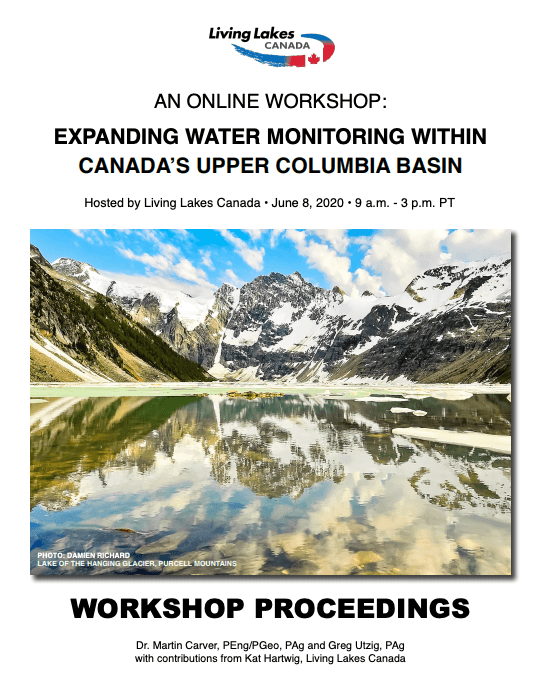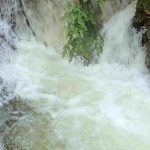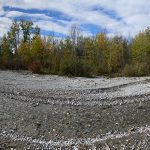A water monitoring framework for the Upper (Canadian) Columbia Basin
 Living in a changing climate poses many difficulties. One of the most pressing issues arises around water: its quality, and its availability. Water monitoring within a standardized framework is necessary to collect this data, and there has been a documented need for increased water monitoring in the Canadian Columbia Basin for well over a decade (see “Background” below).
Living in a changing climate poses many difficulties. One of the most pressing issues arises around water: its quality, and its availability. Water monitoring within a standardized framework is necessary to collect this data, and there has been a documented need for increased water monitoring in the Canadian Columbia Basin for well over a decade (see “Background” below).
This past June, a University of British Columbia study was published, Detecting the Effects of Sustained Glacier Wastage on Streamflow in Variably Glacierized Catchments, that suggests the glacier-melt contributions to August runoff have already passed peak water in the Canadian Columbia Basin. The analysis indicates that there is a clear declining trend, which can have implications for streamflow forecasting and summer water temperature response during hot, dry weather (see the BC Drought Map that classified the East and West Kootenay basins as Level 2 “dry” this past summer; and currently the East Kootenay as Level 2).
The increased frequency of extreme events and the projected decreases in low flows both suggest some urgency for a more comprehensive monitoring network be implemented in order to understand the hydrological and water quality changes, and to mitigate and adapt to the growing risks of changes in flow regimes.
On June 8th 2020, LLC convened and facilitated a hydrology workshop with the purpose of developing recommendations for a phased expansion of the monitoring network for the Upper (Canadian) Columbia Basin (UCB).
DOWNLOAD THE UCB HYDROLOGY WORKSHOP PROCEEDINGS
The workshop objectives were:
- to develop criteria for selecting (priority) watersheds to be included in a regional watershed monitoring network;
- identify monitoring needs related to scientific objectives;
- to develop a process for ranking monitoring needs in terms of both site locations and measured parameters;
- and describe a potential phased implementation.
Greg Utzig, PAg, and Dr. Martin Carver, PEng/PGeo, PAg, provided a proposed approach to expanding the UCB monitoring network, and then the workshop participants actively engaged with the proposal, providing feedback on how it might be improved and implemented.
Background
In 2006, the Pacific Impacts Consortium (PCIC) report for Columbia Basin Trust, Preliminary Analysis of Climate Variability and Change in the Canadian Columbia River Basin: Focus on Water Resources, identified the importance of programs required for water data collection to fill important water data gaps allowing for more informed decision making by all levels of government. A follow up report by PCIC in 2013, Climate Extremes in the Canadian Columbia Basin: A Preliminary Assessment, predicted many of the climate change impacts we are currently experiencing in the Columbia Basin.
In 2017, a report released by the Trust identified the current state of knowledge of water quality and quantity in the Columbia Basin. The report, Water Monitoring and Climate in the Upper Columbia Basin, Summary of Current Status and Opportunities, highlights data gaps, a need for a coordinated monitoring effort, and a “streamlined archival and retrieval technologies” for water data. This report prompted Living Lakes Canada to organize and co-convene a conference in late 2017 — An Open Source Data Dialogue Towards a Columbia Basin Water Monitoring Framework — where the need for a water monitoring framework and data hub was agreed upon by the water data experts from around North America who were in attendance.
Working off information from the aforementioned reports and conference proceedings, Living Lakes Canada began to facilitate the coordination of logistics around filling the identified data gaps, involving volunteer and paid steering committee members, various agencies, industry, academia and community organizations. with the participation and collaboration of First Nations. The Columbia Basin Water Monitoring Collaborative (Collaborative) and the Columbia Basin Water Hub online database were born.
UCB Water Data Hub
The Columbia Basin Water Hub was created out of the need for a central place to gather and archive past, present, and future water quantity and quality data, as well as other types of water data such as glaciers, wetlands, and groundwater. The Water Hub is an open data “library” that can accommodate any file type where anyone can find a variety of data that refers to water within the Columbia Basin. Through this database we aim to house the data gaps that are identified by the Collaborative. The Water Hub will allow for informed, data-driven decision making with our Basin, offering a holistic approach to water management.
 LLC is making progress towards finalizing the Columbia Basin Water Hub as a repository for water quantity and quality data, and other water-related data. Recently, we have managed to solidify different categories of data that are important to monitoring groups within the Columbia Basin. We have also created a user manual that guides database users and we have conducted testing of the database with different people from around the Basin.
LLC is making progress towards finalizing the Columbia Basin Water Hub as a repository for water quantity and quality data, and other water-related data. Recently, we have managed to solidify different categories of data that are important to monitoring groups within the Columbia Basin. We have also created a user manual that guides database users and we have conducted testing of the database with different people from around the Basin.
Currently we are defining data governance for the database, to ensure its long-term success. This includes ensuring provincial and national metadata standards will be met by user groups. Our original fall launch date was delayed due to a longer testing period, but we are working hard to create an accessible, thorough and quality data portal that meets provincial water data standards in order to empower individuals, communities, and decision making groups.
Direct questions about the Columbia Basin Water Hub to Database Manager Santiago Botero: santiago@livinglakescanada.ca





